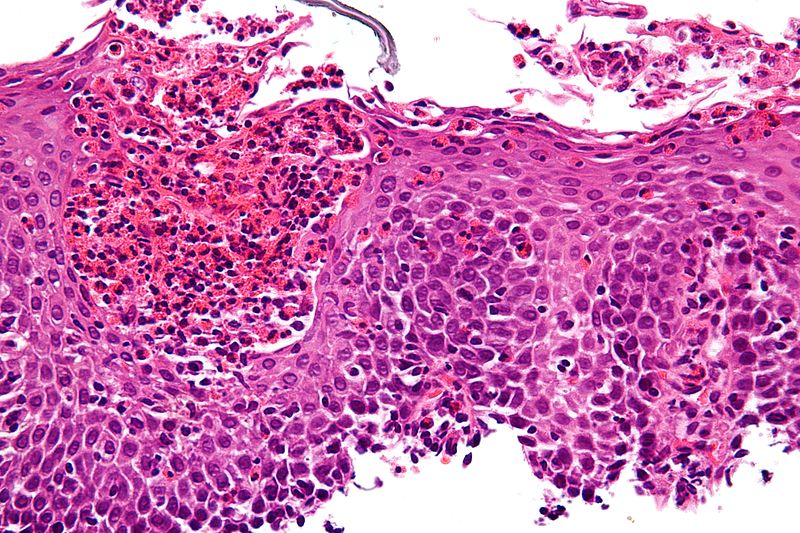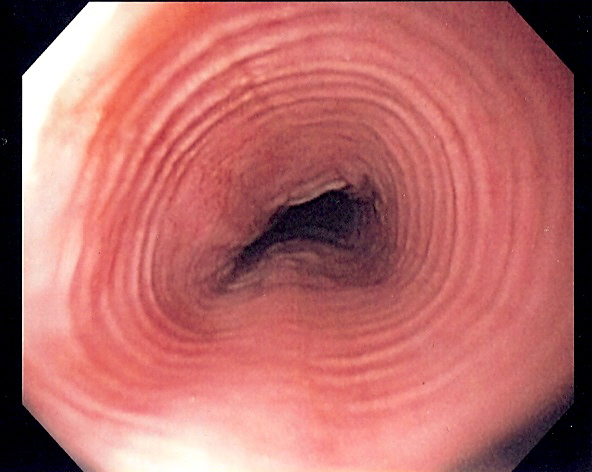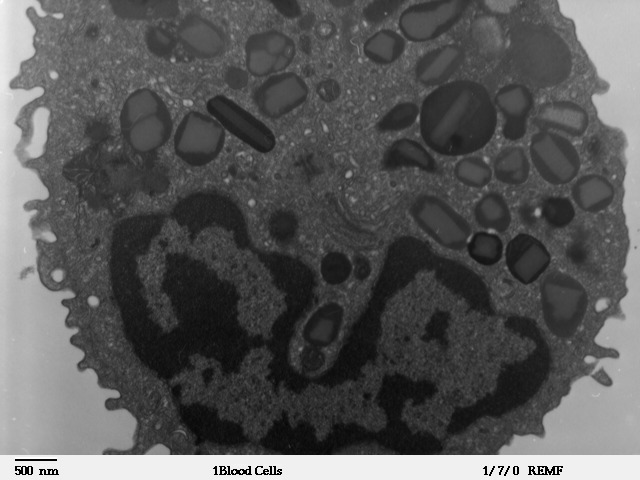[1]
Thomas LL, Kubo H, Loegering DJ, Spillard K, Weaver AJ, McCormick DJ, Weiler C, Gleich GJ. Peptide-based analysis of amino acid sequences important to the biological activity of eosinophil granule major basic protein. Immunology letters. 2001 Oct 1:78(3):175-81
[PubMed PMID: 11578692]
Level 3 (low-level) evidence
[2]
Oxvig C, Gleich GJ, Sottrup-Jensen L. Localization of disulfide bridges and free sulfhydryl groups in human eosinophil granule major basic protein. FEBS letters. 1994 Mar 21:341(2-3):213-7
[PubMed PMID: 8137941]
Level 3 (low-level) evidence
[3]
Barker RL, Gleich GJ, Pease LR. Acidic precursor revealed in human eosinophil granule major basic protein cDNA. The Journal of experimental medicine. 1988 Oct 1:168(4):1493-8
[PubMed PMID: 3171483]
[4]
Popken-Harris P, McGrogan M, Loegering DA, Checkel JL, Kubo H, Thomas LL, Moy JN, Sottrup-Jensen L, Snable JL, Kikuchi MT. Expression, purification, and characterization of the recombinant proform of eosinophil granule major basic protein. Journal of immunology (Baltimore, Md. : 1950). 1995 Aug 1:155(3):1472-80
[PubMed PMID: 7543523]
[5]
Akuthota P, Weller PF. Spectrum of Eosinophilic End-Organ Manifestations. Immunology and allergy clinics of North America. 2015 Aug:35(3):403-11. doi: 10.1016/j.iac.2015.04.002. Epub 2015 Jun 17
[PubMed PMID: 26209892]
[6]
Wassom DL, Gleich GJ. Damage to Trichinella spiralis newborn larvae by eosinophil major basic protein. The American journal of tropical medicine and hygiene. 1979 Sep:28(5):860-3
[PubMed PMID: 484767]
[7]
Ogasawara H, Furuno M, Edamura K, Noguchi M. Peptides of major basic protein and eosinophil cationic protein activate human mast cells. Biochemistry and biophysics reports. 2020 Mar:21():100719. doi: 10.1016/j.bbrep.2019.100719. Epub 2019 Dec 25
[PubMed PMID: 32072023]
[8]
Weiler JM, Edens RE, Bell CS, Gleich GJ. Eosinophil granule cationic proteins regulate the classical pathway of complement. Immunology. 1995 Feb:84(2):213-9
[PubMed PMID: 7750997]
[9]
Rohrbach MS, Wheatley CL, Slifman NR, Gleich GJ. Activation of platelets by eosinophil granule proteins. The Journal of experimental medicine. 1990 Oct 1:172(4):1271-4
[PubMed PMID: 2212954]
[10]
Lehrer RI, Szklarek D, Barton A, Ganz T, Hamann KJ, Gleich GJ. Antibacterial properties of eosinophil major basic protein and eosinophil cationic protein. Journal of immunology (Baltimore, Md. : 1950). 1989 Jun 15:142(12):4428-34
[PubMed PMID: 2656865]
[11]
Temkin V, Aingorn H, Puxeddu I, Goldshmidt O, Zcharia E, Gleich GJ, Vlodavsky I, Levi-Schaffer F. Eosinophil major basic protein: first identified natural heparanase-inhibiting protein. The Journal of allergy and clinical immunology. 2004 Apr:113(4):703-9
[PubMed PMID: 15100677]
[12]
Meirovitz A, Goldberg R, Binder A, Rubinstein AM, Hermano E, Elkin M. Heparanase in inflammation and inflammation-associated cancer. The FEBS journal. 2013 May:280(10):2307-19. doi: 10.1111/febs.12184. Epub 2013 Mar 4
[PubMed PMID: 23398975]
[13]
Kleine TJ, Gleich GJ, Lewis SA. Eosinophil major basic protein increases membrane permeability in mammalian urinary bladder epithelium. The American journal of physiology. 1998 Jul:275(1):C93-C103. doi: 10.1152/ajpcell.1998.275.1.C93. Epub
[PubMed PMID: 9688839]
[14]
Acharya KR, Ackerman SJ. Eosinophil granule proteins: form and function. The Journal of biological chemistry. 2014 Jun 20:289(25):17406-15. doi: 10.1074/jbc.R113.546218. Epub 2014 May 6
[PubMed PMID: 24802755]
[15]
Simon D, Simon HU, Yousefi S. Extracellular DNA traps in allergic, infectious, and autoimmune diseases. Allergy. 2013 Apr:68(4):409-16. doi: 10.1111/all.12111. Epub 2013 Feb 15
[PubMed PMID: 23409745]
[16]
Jacoby DB, Gleich GJ, Fryer AD. Human eosinophil major basic protein is an endogenous allosteric antagonist at the inhibitory muscarinic M2 receptor. The Journal of clinical investigation. 1993 Apr:91(4):1314-8
[PubMed PMID: 8473484]
[17]
Carrington CB, Addington WW, Goff AM, Madoff IM, Marks A, Schwaber JR, Gaensler EA. Chronic eosinophilic pneumonia. The New England journal of medicine. 1969 Apr 10:280(15):787-98
[PubMed PMID: 5773637]
[18]
Ramirez GA, Yacoub MR, Ripa M, Mannina D, Cariddi A, Saporiti N, Ciceri F, Castagna A, Colombo G, Dagna L. Eosinophils from Physiology to Disease: A Comprehensive Review. BioMed research international. 2018:2018():9095275. doi: 10.1155/2018/9095275. Epub 2018 Jan 28
[PubMed PMID: 29619379]
[19]
Pégorier S, Wagner LA, Gleich GJ, Pretolani M. Eosinophil-derived cationic proteins activate the synthesis of remodeling factors by airway epithelial cells. Journal of immunology (Baltimore, Md. : 1950). 2006 Oct 1:177(7):4861-9
[PubMed PMID: 16982928]
[20]
Wehling-Henricks M, Sokolow S, Lee JJ, Myung KH, Villalta SA, Tidball JG. Major basic protein-1 promotes fibrosis of dystrophic muscle and attenuates the cellular immune response in muscular dystrophy. Human molecular genetics. 2008 Aug 1:17(15):2280-92. doi: 10.1093/hmg/ddn129. Epub 2008 Apr 21
[PubMed PMID: 18430716]
[21]
Tai PC, Ackerman SJ, Spry CJ, Dunnette S, Olsen EG, Gleich GJ. Deposits of eosinophil granule proteins in cardiac tissues of patients with eosinophilic endomyocardial disease. Lancet (London, England). 1987 Mar 21:1(8534):643-7
[PubMed PMID: 2882081]
[22]
Leiferman KM, Ackerman SJ, Sampson HA, Haugen HS, Venencie PY, Gleich GJ. Dermal deposition of eosinophil-granule major basic protein in atopic dermatitis. Comparison with onchocerciasis. The New England journal of medicine. 1985 Aug 1:313(5):282-5
[PubMed PMID: 3892296]
[23]
Peters MS, Schroeter AL, Kephart GM, Gleich GJ. Localization of eosinophil granule major basic protein in chronic urticaria. The Journal of investigative dermatology. 1983 Jul:81(1):39-43
[PubMed PMID: 6345685]
[24]
Talley NJ, Kephart GM, McGovern TW, Carpenter HA, Gleich GJ. Deposition of eosinophil granule major basic protein in eosinophilic gastroenteritis and celiac disease. Gastroenterology. 1992 Jul:103(1):137-45
[PubMed PMID: 1612323]
[25]
Peterson KA, Gleich GJ, Limaye NS, Crispin H, Robson J, Fang J, Saffari H, Clayton F, Leiferman KM. Eosinophil granule major basic protein 1 deposition in eosinophilic esophagitis correlates with symptoms independent of eosinophil counts. Diseases of the esophagus : official journal of the International Society for Diseases of the Esophagus. 2019 Dec 30:32(11):. pii: doz055. doi: 10.1093/dote/doz055. Epub
[PubMed PMID: 31310661]
[26]
Kim CK, Callaway Z, Kim DW, Kita H. Eosinophil degranulation is more important than eosinophilia in identifying asthma in chronic cough. The Journal of asthma : official journal of the Association for the Care of Asthma. 2011 Dec:48(10):994-1000. doi: 10.3109/02770903.2011.623335. Epub 2011 Oct 24
[PubMed PMID: 22022864]
[27]
Van Zele T, Claeys S, Gevaert P, Van Maele G, Holtappels G, Van Cauwenberge P, Bachert C. Differentiation of chronic sinus diseases by measurement of inflammatory mediators. Allergy. 2006 Nov:61(11):1280-9
[PubMed PMID: 17002703]



